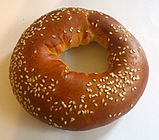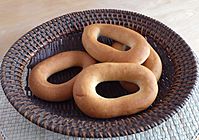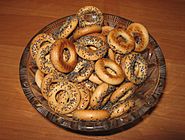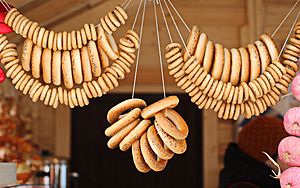Bublik facts for kids

Poppy seed bublik, baranka and sushka
|
|
| Alternative names | Baranka |
|---|---|
| Type | Bread |
| Place of origin | Ukraine (bublik), Belarus (baranka) |
| Region or state | Eastern Europe |
| Associated national cuisine | Belarus, Lithuania, Russia, Ukraine |
| Main ingredients | Flour, milk, sugar, butter, salt, egg whites |
Bublik (also called booblik or bublyk) is a popular ring-shaped bread roll from Eastern Europe. It's made from a special dough that uses yeast. Before baking, the dough rings are briefly boiled in water. This gives them a unique texture.
Contents
What are Bubliks and Similar Breads?
Many ring-shaped breads are popular in Eastern Europe. A Ukrainian bublik is a bit like a bagel, but it's usually bigger. It also has a larger hole in the middle. Bubliks are often drier and chewier than bagels.
Russian baranka is another type of ring-shaped bread. It's smaller and thinner than a bublik. It's also drier.
Sushka is even smaller and drier. It's usually about 5 centimeters (2 inches) wide. Sushki are very hard, almost like a cracker.
In countries like Russia and Ukraine, "bublik" is often used for any of these ring-shaped breads. "Baranka" is also a common general name. In Belarus, it's called abaranak. In Lithuania, it's known as riestainis or baronkos.
The Polish obwarzanek is made in a similar way. However, the most common type, the obwarzanek krakowski, has a braided shape.
Where Did the Name Come From?
The word "bublik" comes from an old Slavic word meaning "bubble." This makes sense because of its round, airy shape.
The Russian word "baranka" comes from a word meaning "scalded" or "parboiled." This refers to how the dough is boiled before baking. The Belarusian and Polish names for similar breads also come from this same idea.
The History of Bubliks
The first time a bread like the bagel was written about was in 1610. This was in the city of Kraków, Poland. This type of bread then spread across Poland. It reached Ukraine, where the bublik got its current shape.
The word "bublik" was first used in Russian texts in the 1700s. A book from 1717 mentioned "wheat bublik."
The baranka was first mentioned in Russian writings in the 1600s. In 1665, a monastery record noted buying "Baranki and eggs." In the 1800s, the town of Valday was famous for its baranki. Famous writers like Alexander Pushkin even mentioned them.
Some historians believe the Russian baranka started in what is now Belarus. A town called Smarhon’ was known for making them. People said baranki were even used to feed bears at a local bear training school! Smarhon' baranki were a popular treat at the Saint Casimir's Fair in Vilnius.
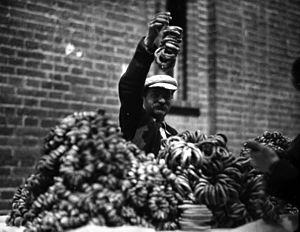
How Bubliks are Made
Bubliks are made from a dough that uses yeast. The dough often includes milk, butter, and egg whites. It's usually a bit sweet. Many bubliks have poppy seeds added to the dough. You can also find savory bubliks. These don't have sugar. Instead, they might have grated cheese or onion juice.
Professional bakers sell bubliks in their shops. You can also find them at country fairs and local markets. They are often sold in bundles, strung together on a string.
In Belarus, Russia, and Ukraine, bubliks are often seen as a type of pastry, not just bread. People usually eat them with tea or coffee. Because of this, the dough is often sweeter and denser than bagel dough. They are also often brushed with egg yolk to make them shiny. The most popular kind of bublik has a lot of poppy seeds on it.
How to Enjoy Bubliks
Bubliks are often eaten plain. But it's also common to dip them into tea. This tradition started because sushki and baranki were very dry. Dipping them made them easier to eat.
Another way to eat bubliks is to break them into pieces. Then, you can eat them with jam (varenye), sour cream (smetana), or other dips. While they are often eaten with tea, bubliks are usually not considered a breakfast food, unlike modern bagels.
Ukrainian Surname
The word Bublik is also a last name in Ukraine. You'll find it mostly in Ukraine and Southern Russia.
See also
 In Spanish: Búblik para niños
In Spanish: Búblik para niños


